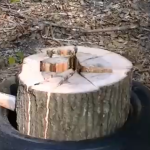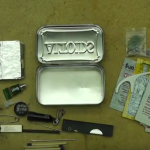Find an Embankment

The foundation of the shelter is in an embankment that rests more than three feet above the ground. You should look for one that already has its outer face exposed from erosion or due to branches, foliage or vegetation. You can also dig out the side of an embankment and create a face as well. The idea is to create a hole somewhere at or below the midpoint for a fire and then dig out a vent or chimney on top. The flat face will also support the main beam for your shelter that will attach to an “A” frame on the other end.

You can also cut out a large notch on the face of the embankment for the fire pit and place some branches, log or a beam across the top. Make sure that you also cut out a notch across the top so that the wood will be flush against the top level of the embankment. Cover it with some stones and dirt to secure it in place, and the space behind the log will serve as the chimney for your fire.
Building the Shelter
Find a branch that is about six feet long and set it aside. Build an “A” frame out of three branches that will meet at the same level as the top of your embankment or beam above the fire hole. Make sure that the frame has a flat face that can be turned inward and give you maximum space for shelter. Secure the branches with some cordage or soft tree bark or other foliage. Attach the beam to the top of the A frame and secure it as well.

You can either drape some plastic tarp over the frame to protect your from the elements, or you can also reinforce the frame and use foliage as a natural form of cover. Using foliage will help you to better blend in with the surroundings and it also “breathes” which means that it will insulate the shelter while also supporting the passage of air. This is important for long-term use, and you will notice that you feel more comfortable and less “stifled” if you use natural cover instead of the tarp. However, it is up to you to decide what is best based on your particular needs.
If you decide to use natural cover, you will need to reinforce the frame so that it will be able to support leafy or pine branches as well as debris from the forest. The easiest way to do this is by following the width of the A frame and attaching branches every foot or so across the main support beam. Secure them with some cordage or natural material. You don’t need a lot because the branches will also support the frame once they are installed. You may also want to consider attaching another long beam or two about halfway down the side, horizontally, for some additional stability. The goal is to be able to attach layer upon layer of branches and debris until you make thick walls that will keep you sheltered from the elements.

All you need to do now is build the fire by using some kindling and small sticks until you can add larger ones as it grows. Just make sure that your fire hole is large enough to accommodate enough material to keep it going for long periods of time. Also, make sure that the smoke is going out of the chimney instead of into your shelter. Try this awesome trick out for yourself and see how this simple solution is one of the best options to consider if you are stuck in the wild with minimal resources.
More Articles From This SIte
Pages:
- 1
- 2













